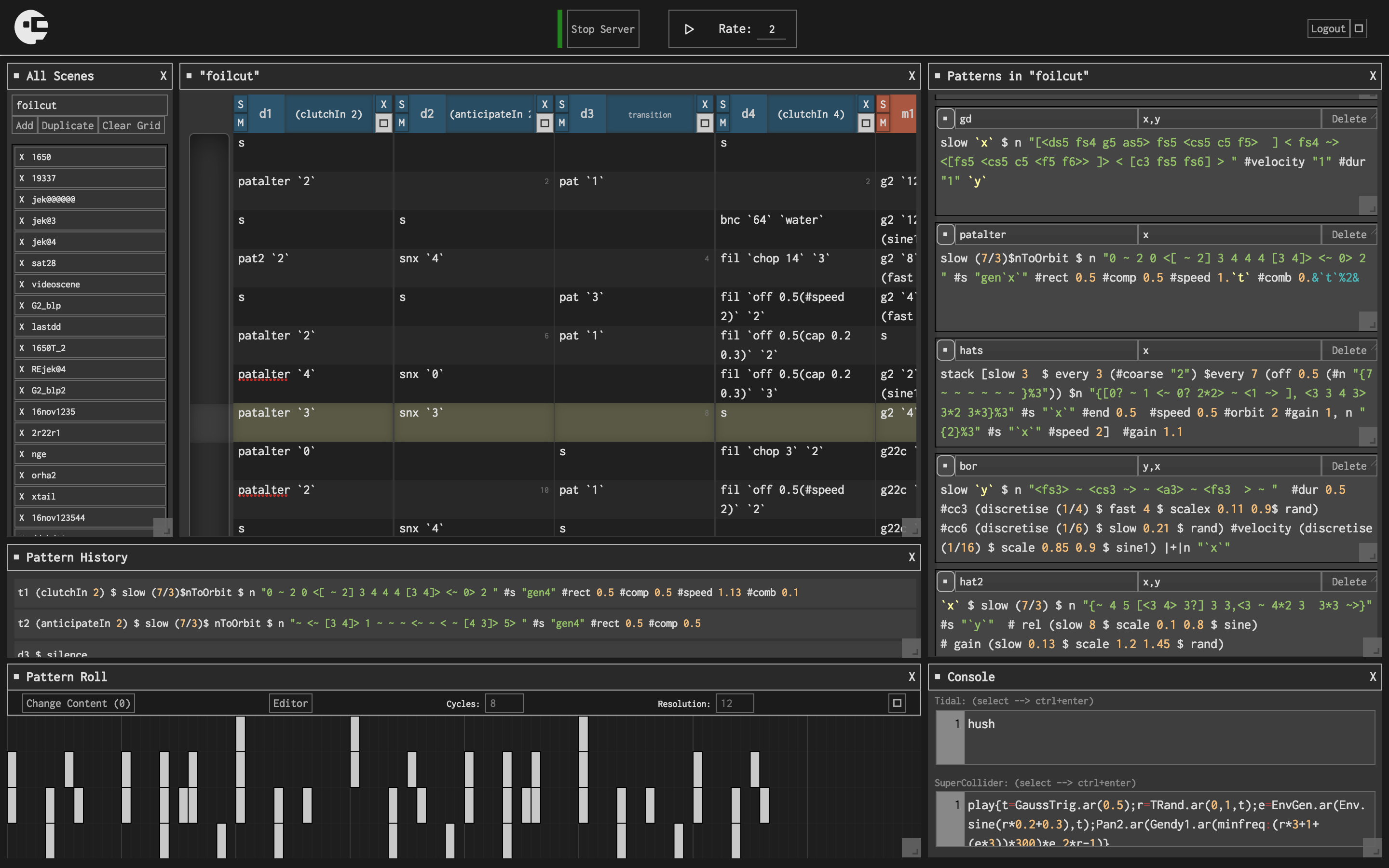Siren, is a tracker interface that embodies abstractions where programming is realized as the medium for pattern sequencing in a modular fashion. It is based on a hierarchical structure that consists of scenes and channels. Separate channels have independent patterns; a complete song consists of a master list of repeated patterns.
Supported programming languages :
- SuperCollider
- Haskell/TidalCycles
Note: This is a beta release (*v0.6), and it has not been tested comprehensively. If you come across a bug, please do submit an issue, and/or create a pull request of you feel like participating in its development.
You can get Siren either by downloading repository as a ZIP file at https://github.com/cannc4/siren, or by using the command line to clone the repository.
git clone https://github.com/cannc4/Siren.gitMake sure the latest versions of following software are installed for your system user
- SuperCollider
- NodeJS (Make sure
npmis globally installed) - TidalCycles
After setting up Haskell, run following command :
cabal install aesonThen follow these lines to install package dependencies:
cd path/to/downloaded/repo
npm inpm run sirennpm startIn order for Siren to find the local dependencies, you need to edit full paths in the Config Paths modules in the software according to your file system formatting, and save the file (Alternatively, this can be done directly in ./server/save/paths.json).
Copy paste your startup code to ./config/scd-start-default.scd and ./config/tidal-boot-default.hs, and make sure you don't modify the required code for Siren
Note: Make sure SuperCollider is either idle or closed before moving on.
Now you can start the server and interface separately:
npm run siren
npm startThis will start the app in browser at localhost:3000
You can also run the electron app with:
npm run sirencalternatively on MacOS:
./siren.shand on Windows, double click on:
siren.batTested with Chrome on Windows 10 and MacOS High Sierra
You can toggle visibility of every module using the right-click context menu.
Scenes are the core of Siren and a scene serves as a framework to the composition. Each scene comprises of unique channels, global modifiers and patterns.
Different channel types can be added with right mouse click. Once a channel is added to the sequencer, the parameters and layout can be adjusted dynamically. Each cell is a textbox allowing any type of text input. Patterns can be looked up from the dictionary with their names and parameters. When a cell is active, it triggers the pattern with appropriate name and applies parameters in an ordered fashion. See parameters for various types.
Please note that Tidal channel names has to be defined appropriately in tidal-boot-default.hs or compiled using console.
The cells of the channels serve as a canvas for pattern names and pattern parameters. Pressing Enter on the cells selects the cell. Once in selection mode, you can navigate the cells with arrow keys. The selected cell can be compiled with Alt + Enter . Multiple cells can be selected using the Shift + arrow keys which then can be copied and pasted to other parts of the grid.
Siren allows patterns to be parameterized and can be called with different parameters from different cells in the channel.
|x,y| returns a random value within the x and y
Disclaimer: Please omit the channel number and dollar sign on Tidal commands (instead of d1 $ sound "bd" just write sound "bd")
Tidal patterns are stored in the dictionary on the right hand side of the interface. This dictionary is unique for each scene and interacts with the sequencer in terms of parameters and calls.
t represents the temporal parameter for each timer and it can be used in expressions to create complex values, especially with math expressions.
Mathematical expressions can be used in the patterns in the dictionary, parser evaluates the expressions when enclosed with & symbol.
Any character sequence inside Siren pattern can be parameterized by surrounding desired spot with ` symbol (like surrounding a phrase for Markdown code block). Using this feature, you can not only pass well-tuned values dynamically, but also pass anything you want.
n `x` # s `y` This module stores the successfully compiled Tidal patterns to keep track of the running sequences.
This module serves as a CLI (Command-Line-Interface) to Haskell and SuperCollider.
There are two sections dedicated to appending and prepending to the running code. ctrl+enter activates the code and sections can be recalled by creating presets. Pressing Rec button saves the active modifiers. shift+ click clears the desired slot and alt+ click overwrites it. These modifiers are applied to the patterns shown in the pattern history section (i.e. active patterns). Channels that you want to target can also be specified using the channel section in the submenu. Writing 1 2 will make the modifiers only affect the first two channels, 0 is a special case and means modifiers will be applied to all channels in the scene. Last row is the global parameter that can be dynamically added to the system.
In this module, it’s possible to set various settings of Siren such as startup config.
This module serves as a debug console for GHC.
(Under Development) Inspired by the piano-roll in traditional DAWs, operates as the playback visualization tool. It fetches the future trigger values from Tidal and places them on top of the current playback information. To be able to use this tool, pattern names needs to be written with x prefix instead of the usual d such as x1 instead of d1.
The horizontal axis denotes quantized time bins, and vertical lists the names of unique samples and notes. Default sequence length is 8 seconds and each second is quantized into 12 bins. Both parameters can be edited using the dedicated fields on the interface.
(Under Development) This module runs GLSL code which will be used as a visual synthesizer in synch with the current playback.
